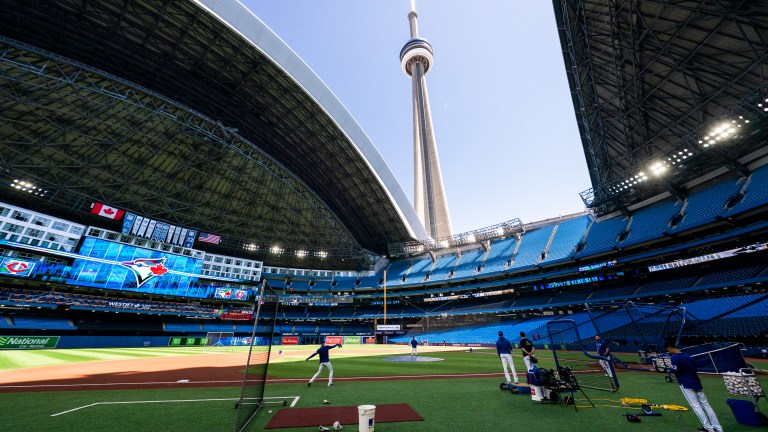Re-Award Season: 1982 AL Cy Young, Dave Stieb
One of the most underrated pitchers in MLB history, Dave Stieb deserved to win the AL Cy Young in 1982 but was snubbed for a lack of wins.

Some history is revisionist history. With respect to those honored with postseason awards, there were instances in which someone was more deserving. Understanding changing criteria and added scrutiny recently toward the voting process, we began our look back at awards that need a redo.
A common theme when examining how end-of-year awards were determined is the changing value of certain statistics. For everyone — position players and pitchers — it’s Wins Above Replacement (WAR), which didn’t come into the common baseball vernacular until the 21st century.
For pitchers, it’s measurements like ERA+ and wins.
American League batters in 1982 hit 2,080 home runs and struck out just 12.6 percent of the time. Today’s batters hit them out more frequently and miss them more too, even last year with the pitch clock. In 1982 there were just 5,582 pitching appearances, about half of what we see now.
Starting pitchers pitched longer into games and more frequently, while relievers were used less often and for longer outings.
Describing and understanding how pitching usage has changed and how we judge pitching quality these days can better be explained by comparing the voting results with the major statistical categories from 41 years ago.
| Pitcher | Team | W-L | ERA | ERA+ | IP | BB | SO | WHIP |
| Pete Vuckovich | MIL | 18-6 | 3.34 | 114 | 223.2 | 102 | 105 | 1.502 |
| Jim Palmer | BAL | 15-5 | 3.13 | 129 | 227.0 | 63 | 103 | 1.137 |
| Dan Quisenberry | KC | 9-7 | 2.57 | 159 | 136.2 | 12 | 46 | 1.010 |
| Dave Stieb | TOR | 17-14 | 3.25 | 138 | 288.1 | 75 | 141 | 1.200 |
| Rick Sutcliffe | CLE | 14-8 | 2.96 | 140 | 216.0 | 98 | 142 | 1.259 |
| Geoff Zahn | CAL | 18-8 | 3.73 | 109 | 229.1 | 65 | 81 | 1.265 |
| Bill Caudill | SEA | 12-9 | 2.35 | 181 | 95.2 | 35 | 111 | 1.045 |
| Bob Stanley | BOS | 12-7 | 3.10 | 140 | 168.1 | 50 | 83 | 1.253 |
| Dan Petry | DET | 15-9 | 3.22 | 126 | 246.0 | 100 | 132 | 1.301 |
The winner, Milwaukee’s Pete Vuckovich, has no bold type. He does have more credits on his IMDB page. Vuckovich’s 1.502 WHIP is higher than everyone else in the top nine and his ERA+ is lower than the others.
What did matter was that he had 18 victories. And while that doesn’t mean much today, it means something during a time when pitchers stayed on the mound longer and thus had more of an effect on their team’s success or failure.
But Vuckovich had the luxury of pitching behind the best offense in baseball. Robin Yount, Paul Molitor, Cecil Cooper, and Ted Simmons headed a lineup that produced more runs and wins than the rest of the league.
While Dave Stieb is our unofficial winner, it’s not a slam dunk. Rick Sutcliffe has the lowest ERA among starters. Jim Palmer has the lowest WHIP. Not that seasons past and future play a part, but Stieb — the most underappreciated pitcher of the 1980s — is certainly owed one.
He pitched almost his entire career as a Toronto Blue Jays starter and is undoubtedly a product of wrong place, wrong time. For a deeper dive into his search for recognition, accolades, and single-game accomplishment, nothing is better than this four-part video series.
For the sake of our focused review, we’ll keep it to how he compared to the rest of the American League pitchers in ’82 — and how the best AL pitchers compared to the eventual Cy Young Award recipient.
Stieb made 38 starts for the Jays, throwing 288.1 innings. That, by today’s standards, looks like a typo. It was even a lot in 1982. So were 19 complete games. He struck out just 4.4 batters per nine innings, a rather inconsequential number. Everything else suggests he was the best pitcher in the league.
In our revisionist redo, we can take WAR into account. This is where Stieb stands apart. He pitched for the AL East’s last-place team which produced the second-fewest runs in the league.
Therefore, his opportunities to get a higher amount of wins, the metric so high in the estimation of the voters, were very slim. Stieb lost 14 games, but by looking at his ERA or his many other league-leading statistics he had very little fault in those outcomes.
More evidence is a stat called Run Support Per Game. Stieb’s was 3.9, among the 10 worst for AL starters. Vuckovich’s was 5.2.
Stieb led the AL in more traditional stats like complete games (19) and shutouts (5) that season as well as sabermatritian-friendly measurements like Adjusted Pitching Runs, Adjusted Pitching Wins, Base-Out Runs Saved (RE24), and Situational Runs Saved (WPA/LI). Advanced metrics make Steib look very good, not just this year but in many years.
At age 24, Stieb began a stretch of four consecutive seven-plus WAR seasons. Stieb improved his ERA in each of those and started the All-Star Game for the AL in ’83 and ’84. Yet the Cy Young eluded him every year. But 1982 was the most egregious ruling of a career that deserved recognition for his excellence.
